
Varèse
Edgard Varèse was born in Paris, December 22, 1885 and died in New York, November 6, 1965. Although born in France, Varèse lived and worked most of his life in the United States. A pioneer of the avant-garde movement in music, Varèse experimented with electronic music, musique concréte;, and some highly original experimentation in the uses and organization of rhythm. The works for which he is best known are those in which he completely rejects traditional melody and harmony, instead building these compositions from blocks of sounds, relying on tone color, texture and rhythm. Varèse’s most original work exemplifying this technique is probably Ionisation, which is scored for a huge percussion ensemble, piano, and sirens.
Vaughan Williams
Ralph Vaughan Williams lived between 1872 and 1958. He is considered to be a romantic composer. His works include Fantasia on Greensleeves, The Pilgrim’s Progress, Fantasia on a Theme of Tallis and Mass in G Minor.
Verdi
Giuseppe Verdi lived between 1813 and 1901. He is considered to be a romantic composer. He was an Italian operatic composer who achieved his first major success with Nabucco (1842). He was the leading figure of Italian music in the nineteenth century and made important contributions to the development of opera.
The singing melodies of his popular operas, like Rigoletto, La Traviata, Il Trovatore, Aida, have come to represent Italian opera to much of the world. The late operas Otello and Falstaff crowned his achievement.
de Victoria
One of the works of Tomás Luis de Victoria was chosen in Best 100 Classical Pieces of the Millenium.
Vivaldi
Antonio Vivaldi lived from 1678 until 1741 and was considered to be a baroque composer. He was an Italian composer of instrumental music and opera. He was important in the development of the concerto. Vivaldi was ordained as a priest in 1703, but gave up saying Mass due to a chest illness. From 1704 until 1740, he taught violin at an orphanage, gave recitals, played the violin in operatic performances and produced some operas of his own.
The concertos that Vivaldi wrote helped define the genre in the Baroque and into the Classical era. These normally comprised three movements (fast, slow, fast); the fast movement regularly employed a ritornello form. In this form, an orchestral melody alternates with the freer sections that feature the soloist or soloists. The repetition of the ritornello provides a point of reference for the listener, allowing the soloist to stand out. It also allows the composer a greater degree of freedom in how the soloist’s material is treated.
Vivaldi’s concertos also stand out for the degree of inventiveness that he brought to them. While challenging the player, they also engage the listener. One of his most famous groups of concertos, The Four Seasons, demonstrates this well, and shows the more dramatic and colorful potential of the genre. Each concerto represents a different season, and the music illustrates in sound a picture created by an accompanying poem. Vivaldi uses his ingenuity to take the mundane sounds of daily life (the barking of a dog, the buzzing of flies), along with more dramatic sounds (a violent spring storm), and portray them in purely musical language that stands on its own merit. These early examples of program music well deserve their place in the popular canon of classical music.
Works:
Orchestral music, including over 239 violin concertos, including Le quattro stagioni (The Four Seasons), Op.8, Nos.1-4, c.1725), other solo concertos (bassoon, cello, oboe, flute, recorder), double concertos, ensemble concertos, sinfoniasChamber music, including sonatas for violin, cello and flute, trio sonatas
Vocal music, including oratorios (Juditha triumphans, 1716), Mass movements (Gloria), Magnificat, psalms, hymns and motets
Secular vocal music, including solo cantatas and operasHis most famous work, The Four Seasons, was written in 1725.
Vivaldi was a contemporary of Johann Sebastian Bach.
